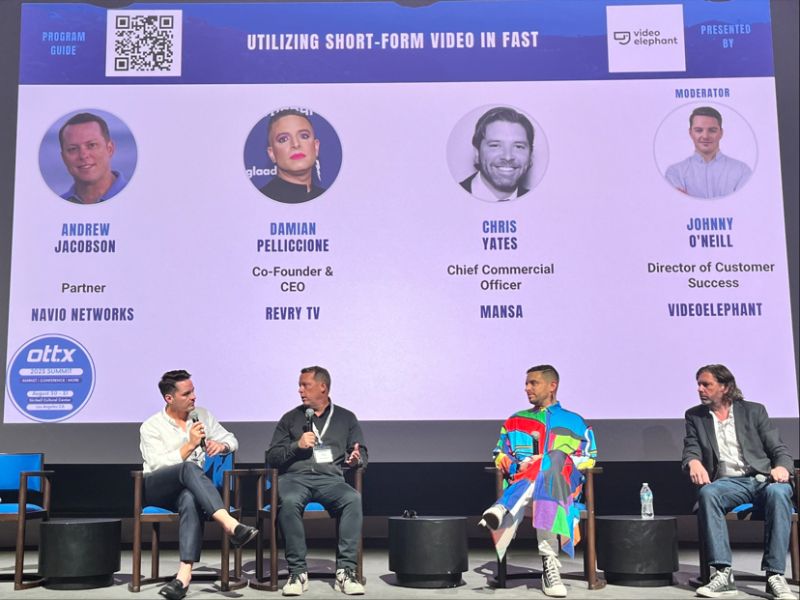The Evolution of Free Ad Supported Television (FAST): Quality, Data-Driven Programming, and the Rise of Short Form Content

Introduction
In the ever-expanding world of Free Ad Supported Television (FAST), where platforms and channels multiply by the day, we’re seeing that the hunger for diverse content remains insatiable.
However, as the FAST ecosystem grows, so does the demand for higher quality content. Quality, in this context, is becoming increasingly subjective, yet it is evident that the industry is shifting towards data-driven programming and prioritizing popular verticals such as True Crime.
At the recent OTT.x Summit I had the pleasure of moderating a panel with industry heavyweights Andrew Jacobson, President, Navio Networks, Damian Pelliccione, Co-Founder & CEO, Revry TV and Chris Yates, Chief Commercial Officer, Mansa. In this article I outline my key takeaways from a fascinating discussion about the latest trends in FAST from some of the industry’s most respected figures.
Data-Driven Programming
One of the most significant trends shaping the FAST landscape is the emphasis on data-driven programming. In this era where data drives decision making across our industry, channel operators are harnessing what data they can get to optimize channel schedules and prioritize top-performing content. This data-driven approach ensures that viewers are presented with content that aligns with their preferences, leading to increased engagement and retention.
At the VideoElephant panel at the recent OTT.x summit, Andrew Jacobson, pointed out how data-driven programming has become a game-changer. By analyzing viewer data, show data, and episode data, programmers can identify patterns and trends that help them make informed decisions about content selection and scheduling. Data-driven programming allows the channel operator to continually highlight the content that their audience responds to. This not only enhances the viewer's experience but increases session length and audience engagement - which in turn creates more advertising opportunities.
Short Form Content Integration
Another trend emerging in the FAST realm is the integration of short form content. Programmers are finding innovative ways to incorporate various content formats into their programming strategies. For instance, Andrew Jacobson explained how short form content is being used strategically to round out channel schedules and meet different ad load requirements.
Traditional 22-minute programming doesn't always align with the ad load requirements of FAST platforms. To bridge this gap, programmers are embracing short form content. These bite-sized episodes and clips allow programmers to slot in relevant short-form content around longer content in order to hit the differing content/ad ratios required by different platforms while also providing a seamless viewer experience. This approach not only adheres to platform requirements but also keeps viewers engaged with a constant stream of captivating content.
Navigating the Challenge of Discovery
While the FAST industry is booming, the challenge of content discovery remains ever-present. However, innovative programmers are rising to the occasion by engaging users in unconventional ways and environments, often with non-traditional TV content.
For instance, both Chris Yates and Damian Pelliccione spoke of having found significant success in engaging audiences through mobile platforms, where short form content takes center stage. By prioritizing short, easily consumable content on mobile devices, they introduce new users to their brands. This serves as an entry point for viewers, gradually drawing them towards consuming longer-format FAST and AVOD content through CTV apps. In essence, these programmers are meeting viewers where they are most active, providing a gateway to their extensive content libraries.
Conclusion
As the FAST landscape continues to evolve, the pursuit of quality content remains paramount. The industry is embracing data-driven programming, ensuring that viewers are presented with content that resonates with their preferences. Additionally, the incorporation of short form content has become a strategic necessity, aligning programming schedules with the ad load requirements of platforms. And to tackle the challenge of content discovery, programmers are exploring new engagement avenues, particularly on mobile platforms, where short form content serves as an enticing introduction to their broader offerings.
In this dynamic and ever-changing world of FAST, innovation is the key to success. Those who adapt to viewer preferences, optimize their schedules through data-driven insights, and creatively engage users will likely find themselves at the forefront of the FAST revolution.
.png?width=2466&height=829&name=VideoElephant_Logo_Main_Black%20(2).png)

